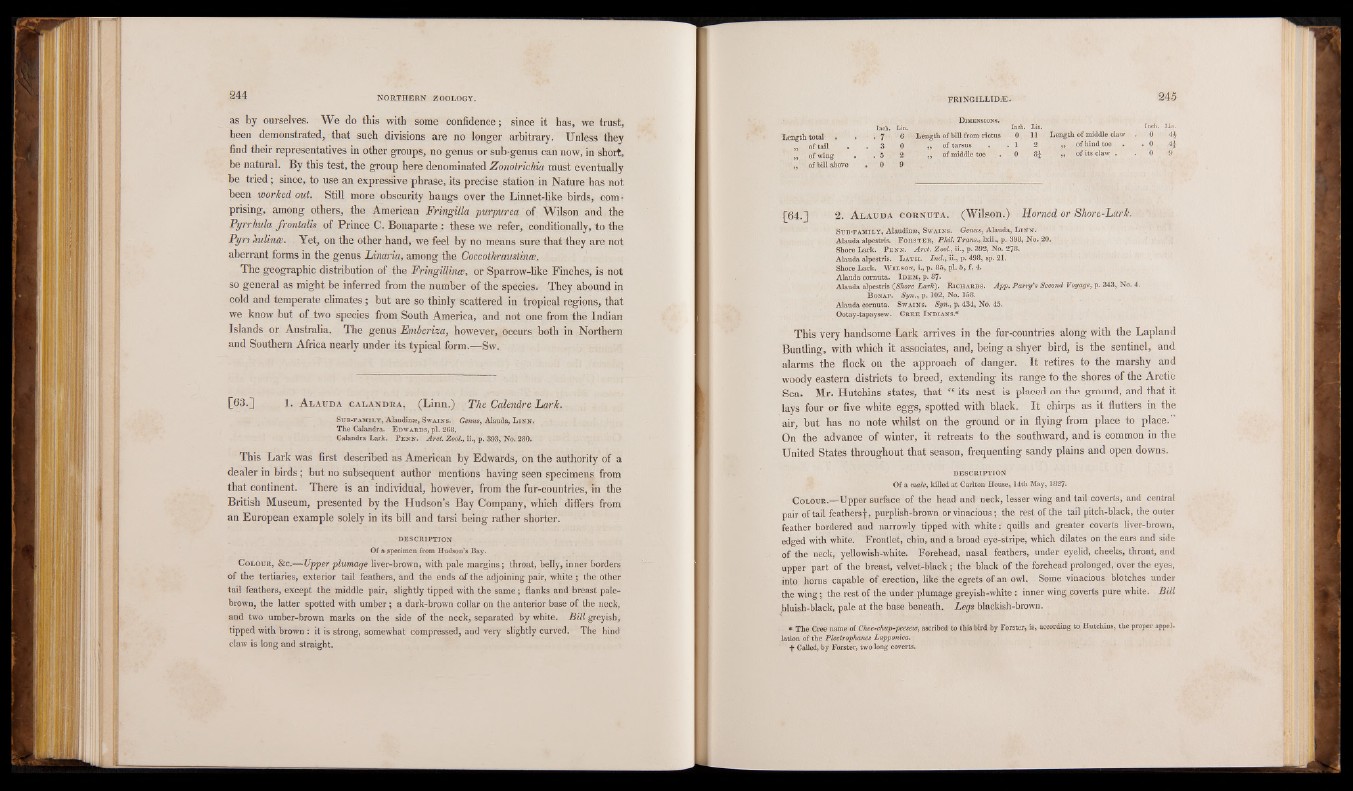
as by ourselves. We do this with some confidence; since it has, we trust,
been demonstrated, that such divisions are no longer arbitrary. Unless they
find their representatives in other groups, no genus or sub-genus can now, in short,
be natural. By this test, the group here denominated Zonotrichia must eventually
be tried; since, to use an expressive phrase, its precise station in Nature has not
been worked out. Still more obscurity hangs over the Linnet-like birds, comprising,
among others, the American Fringilla purpurea of Wilson and the
Pyrrhula frontalis of Prince C. Bonaparte : these we refer, conditionally, to the
P yn hulinte. Yet, on the other hand, we feel by no means sure that they are not
aberrant forms in the genus Linaria, among the Coccothraustinie. The geographic distribution of the Fringillina;, or Sparrow-like Finches, is not
so general as might be inferred from the number of the species. They abound in
cold and temperate climates; but are so thinly scattered in tropical regions, that
we know but of-two species from South America, and not one from the Indian
Islands or Australia. The genus Emberiza, however, occurs both in Northern
and Southern Africa nearly under its typical form.—Sw.
[63.] 1. A l a u d a c a l a n d r a , (Linn.) The Calendre Lark.
Sub-f a m il y , Alaudinse, S w a in s . Genus, Alauda, L in n .
The Calandra. E dw a rds, pi. 268.
Calandra Lark. P e n n . Arct. Zool., ii, p. 393, No. 280.
This Lark was first described as American by Edwards, on the authority of a
dealer in birds; but no subsequent author mentions having seen specimen^ from
that continent. There is an individual, however, from the fur-countries, in the
British Museum, presented by the Hudson’s Bay Company, which differs from
an European example solely in its bill and tarsi being rather shorter.
DESCRIPTION
Of »specimen from Hudson’s Bay.
C olour, &c.— Upper plumage liver-brown, with pale margins; throat, belly, inner borders
of the tertiaries, exterior tail feathers, and the ends of the adjoining pair, white; the other
tail feathers, except the middle pair, slightly tipped with the same; flanks and breast pale-
brown, the latter spotted with umber ; a dark-brown collar on the anterior base of the neck,
and two umber-brown marks on the side of the neck, separated by white. Bill greyish,
tipped with brown : it is strong, somewhat compressed, and very slightly curved. The hind
claw is long and straight.
Inch. Lin. Dimensions. Inch. Lin. Inch. Lin.
Length total . • . 7 - 6 Length of bill from rictus 0 11 Length of middle claw 0
„ of tail . . 3 0 f „ of tarsus • . 1 2 ,, of hind toe . 0
„ of wing •
. 5
2
„ of bill above
. 0
9
„ of middle toe .. 0 8£ „ of its claw . 0 9
[64.] 2. A l a u d a c o r n u t a . (Wilson.); Horned or Share-Lark.
Su b -f a m il y , Alaudinse, Sw a in s . Genus, Alauda, L in n .
Alauda alpestris. F o r s t e r , PMl. Trans., lxii., p. 398, No. 20.
Shore Lark. P e n n . Arct. Zool., ii., p. 392, No. 278.
Alauda alpestris. L a t h . Ind:, ii., p. 498, sp. 21.
Shore Lark. W ilson, i., p. 85, pi. 5, f. 4.
Alauda cornuta. I d em , p. 87* Alauda alpestris (Shore Lark). R ic h a r d s . App. Parry's Second Voyage, p. 343, No. 4.
B onap. Syn., p. 102, No. 158.
Alauda cornuta. S w a in s . Syn., p. 434, No. 45.
Ootay-tapaysew. Cr e e I n d ia n s .*
This very handsome Lark arrives in the fur-countries along with the Lapland
Bunding, with which it associates, and, being a shyer bird, is the sentinel, and
alarms the flock on the approach of danger. It retires to the marshy and
woody eastern districts to breed, extending its range to the shores of the Arctic
Sea. Mr. Hutchins states, that “ its nest is placed on the ground, and that it
lays four or five white eggs, spotted with black. It chirps as it flutters in the
air, but has no note whilst on the ground or in flying from place to place.”
On the advance of winter, it retreats to the southward, and is common in the
United States throughout that season, frequenting sandy plains and open downs.
DESCRIPTION
Of a male, killed at Carlton House, 14th May, 1827*
C olour.—Upper surface of the head and neck, lesser wing and tail coverts, and central
pair of tail feathersf, purplish-brown orvinacious; the rest of the tail pitch-black, the outer
feather bordered and narrowly tipped with white: quills and greater coverts liver-brown,
edged with white. Frontlet, chin, and a broad eye-stripe, which dilates on the ears and side
of the neck, yellowish-white. Forehead, nasal feathers, under eyelid, cheeks, throat, and
upper part of the breast, velvet-black ; the black of the forehead prolonged, over the eyes,
into horns capable of erection, like the egrets of an owl. Some vinacious blotches under
the wing; the rest of the under plumage greyish-white : inner wing coverts pure white. Bill
bluish-black, pale at the base beneath. Legs blackish-brown.
* The Cree name of Chee-chup-peesew, ascribed to this bird by Forster, is, according to Hutchins, the proper appellation
of the Plectrophanes Lapponica.
f Called, by Forster, two long coverts.